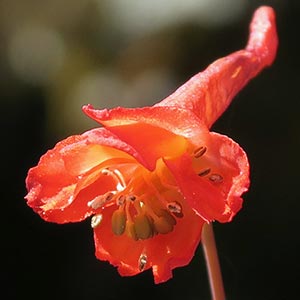Delphinium nudicaule
Delphinium nuttallianum
canyon delphinium, canyon larkspur, orange larkspur, red larkspur, red or orange larkspur, scarlet larkspur
dwarf, meadow, Nuttall's larkspur, or Sonne's larkspur, slim, thin-petal larkspur, two-lobe larkspur, upland larkspur
(15-)20-50(-125) cm;
base reddish, glabrous.
unbranched, 10-40(-70) cm;
base reddish, pubescence variable.
blade round to pentagonal, 2-6 × 3-10 cm; ultimate lobes 3-12, width 5-40 mm (basal), 2-20 mm (cauline).
blade round, 1-6 × 2-12 cm, nearly glabrous; ultimate lobes 5-21, 5 or more extending more than 3/5 distance to petiole, width 1-7(-14) mm (basal), 0.5-6 mm (cauline), widest at middle or in proximal 1/2.
5-20(-69)-flowered;
pedicel (1.5-)2-6(-8) cm, glabrous to glandular-pubescent;
bracteoles 14-20(-30) mm from flowers, green to red, linear, 2-4(-9) mm, glabrous to puberulent.
4-18(-48)-flowered, at least 2 times as long as wide;
pedicel 0.8-6 cm, pubescence variable;
bracteoles 3-8(-18) mm from flowers, green to blue, linear, 3-7 mm, pubescence variable.
sepals scarlet to reddish orange, rarely dull yellow, glabrous, lateral sepals forward-pointing to form pseudotube, (6-)8-13(-16) × 3-6 mm, spurs straight, slightly ascending, (12-)18-27(-34) mm;
lower petal blades elevated, exposing stamens, 2-3 mm, clefts 0.5-1 mm;
hairs sparse, evenly dispersed, yellow.
sepals usually bluish purple, rarely white to pink, puberulent, lateral sepals reflexed or spreading, 8-21 × 3-10 mm, spurs decurved to straight, ascending 20-60° above horizontal, 8-23 mm;
lower petal blades elevated, exposing stamens, blue to purple, except sometimes in white-flowered plants, 4-11 mm, clefts 2-5 mm;
hairs mostly on inner lobes below junction of blade and claw, white, rarely yellow.
13-26 mm, 3.5-4.5 times longer than wide, glabrous.
7-22 mm, 3.5-5 times longer than wide, glabrous to puberulent.
unwinged or sometimes slightly wing-margined;
seed coat cells with surfaces smooth.
winged or not;
seed coat cell surfaces smooth or roughened, blunt hairs absent.
= 16.
= 16.
Delphinium nudicaule
Delphinium nuttallianum
Delphinium nudicaule hybridizes with most other taxa of Delphinium that it encounters. Apparent hybrids involving D. nudicaule, and seen by the author (either afield or as specimens), include D. andersonii, D. antoninum, D. decorum, D. luteum, D. nuttallianum, D. patens, and D. trolliifolium. In addition, garden-grown plants have been hybridized with D. cardinale, D. elatum, D. menziesii, D. parishii, D. penardii, D. tatsienense Franchet, D. triste Fischer ex de Candolle, and D. uliginosum; D. nudicaule does not naturally occur with these species. Delphinium nudicaule is one of the earliest larkspurs to flower in any given locality. Douglas's type collection of D. nudicaule represents plants (synonyms D. sarcophyllum Hooker & Arnott and D. peltatum Hooker, an invalid name) grown under very moist conditions, probably quite near the ocean. The type specimen of D. armeniacum A. Heller represents plants grown under unusually dry conditions.
The Mendocino Indians consider Delphinium nudicaule a narcotic (D. E. Moerman 1986).
(Discussion copyrighted by Flora of North America; reprinted with permission.)
Delphinium nuttallianum represents an extremely difficult complex, with many variations in a number of morphologic traits. The complex has been and continues to be a major source of confusion for identification of Delphinium in North America. Type specimens of D. nuttallianum represent plants growing under dry conditions in open areas. These are typically found at 1200-2000 m in sage scrub or lower montane forest. Delphinium nuttallianum may be confused with D. andersonii, D. antoninum, D. depauperatum, D. gracilentum, and two subspecies of D. patens (subsp. patens and subsp. montanum). Features that may be used to separate D. nuttallianum from the first four, are enumerated under the respective species discussions. From D. patens subsp. patens, D. nuttallianum may be distinguished by its narrower leaf lobes, larger fruits, and more compact inflorescence. The frequent presence of glandular hairs in the inflorescence of D. patens subsp. montanum, contrasted with their absence in D. nuttallianum, will separate these taxa. Dwarfed plants of D. polycladon may be confused with D. nuttallianum. The latter, however may be distinguished by its ringed seeds, and it does not have prominent buds or sigmoid pedicel.
Hybrids have been seen between Delphinium nuttallianum and D. andersonii, D. depauperatum (D. ×burkei Greene), D. distichum (D. ×diversicolor Rydberg), D. nudicaule, and D. polycladon.
(Discussion copyrighted by Flora of North America; reprinted with permission.)


